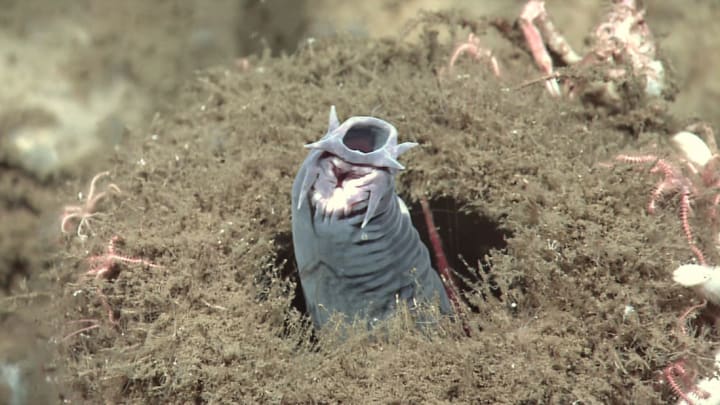The deep-sea squid known as Octopoteuthis deletron has a startling defense mechanism: When threatened, the squid attacks its predator and then pulls away, breaking off the tip of its own arm and leaving it behind as a diversion. As the arm continues to glow and twitch, the squid makes its escape.
But this squid isn't the only creature with a bizarre tactic for keeping itself alive. Here are several other animals with impressive defense mechanisms.
1. THE LIZARD THAT SHOOTS BLOOD FROM ITS EYES
The Texas Horned Lizard is a scary-looking creature. Brown, plump and perfectly camouflaged in its native sandy environment, its first line of defense is its spiky demeanor. If the sharp spikes and horns don't ward off predators, the lizard steps it up a notch and squirts a well-aimed stream of blood out of its eyes. The stream of blood, which can go as far as 5 feet, is mixed with a foul-tasting chemical that wards off predators. But this odd weapon comes at a cost: The lizard may release one-third of its total blood supply this way, amounting to 2 percent of its body mass. Unfortunately, its population numbers are dropping thanks to a threat that won't retreat after a well-aimed squirt: habitat loss due to rapid urbanization in the Lone Star State.
2. THE HAIRY FROG THAT BREAKS ITS OWN BONES

What if every time you felt threatened, your first and only method of defense was to break your own bones and use them for weapons? Meet the hairy frog, a Central African species. When breeding, the male frogs develop thin strands of skin along the sides of their bodies that resemble hair. In theory, these strands also allow the frogs to take in more oxygen while they watch over their eggs. But what's really compelling about this frog is its ability to crack its own toe bones and push them through their skin to form sharp claws, which are great for warding off would-be attackers.
While it's not completely clear what happens to the bones after the threat of attack subsides, researchers believe the bones slide back under the skin when the frog's muscles relax.
3. THE NEWT THAT TURNS ITS RIBS INTO SPIKES

The hairy frog isn't the only amphibian that uses its bones for weapons. When attacked, the Spanish ribbed newt shifts its ribs forward at an angle and pushes them through its stretched skin. The resulting effect is a row of spikes on either side of its body. Like the hairy frog, the newt has to force the bones through its skin every time it is attacked, but the mechanism seems to cause little or no harm to the creature. Maybe one day it'll get its own robot protector: A team of researchers at the the Swiss university EPFL created a robotic salamander inspired by the newt, which they called the Pleurobot (after its scientific name, Pleurodeles waltl).
4. THE TERMITE THAT BLOWS ITSELF UP
Talk about taking one for the team. When under attack, a species of termites found in the French Guiana rain forests sends older worker bugs on suicide missions to defend the whole colony. These older bugs, no longer as useful to the pack as they once were, come equipped with "explosive backpacks" that, over a lifetime, fill with toxic crystals produced by glands in the abdomen. When mixed with salivary gland secretions, these crystals create a toxic liquid that explodes on enemies, paralyzing them and killing the worker at the same time. These termites aren't alone among insects in using a suicidal defensive tactic: When faced with a threat, an ant found in Borneo expands its abdomen until it ruptures, shooting out a toxic liquid.
5. THE FISH THAT SLIMES ITS ENEMIES
Hagfish are eel-shaped marine animals with the incredibly useful ability to slime their enemies. When threatened, the hagfish emit a slime from their pores that, when mixed with water, expands into a gelatinous goo that can either trap predators or suffocate them by clogging their gills. The video above shows a hagfish being attacked 14 separate times by sharks and other big fish, and coming out completely unharmed. Each predator took one bite before immediately spitting the hagfish out and swimming away, gagging. The best time to encounter a hagfish is probably after it's emptied its slime glands withstanding such an onslaught; the glands take three to four weeks to refill.
6. THE SEA CUCUMBER THAT SHOOTS ORGANS OUT OF ITS ANUS

Sea cucumbers can seem pretty boring. There are some 1250 known species of these sedentary creatures in the world, and many of them do indeed look like cucumbers. But when it comes to survival, things get interesting. Like starfish and sea urchins, sea cucumbers are echinoderms, and they can regenerate lost body parts if necessary. This comes in handy when they're threatened. The sea cucumber will expel its internal organs, which are sticky and sometimes contain a toxic chemical that can kill predators. They don't have much of a defense against pollution though, which is a problem, because they're superstar ocean-floor cleaners.
7. THE OPOSSUM THAT PLAYS DEAD

You can't do a roundup like this without at least mentioning the opossum. We typically refer to this creature's infamous defense mechanism as "playing dead," but there's actually nothing playful about it; the act is completely involuntary. Under intense fear, opossums fall into a comatose-like state that can last for hours, long enough to convince any predator that the opossum is already dead. Also unappetizing: Fear causes these animals to emit a corpse-like smell that only adds to their act. Thank the opossum for providing some defense for us too: They eat venomous snakes and ticks, gobbling up to 4000 insects a week.
